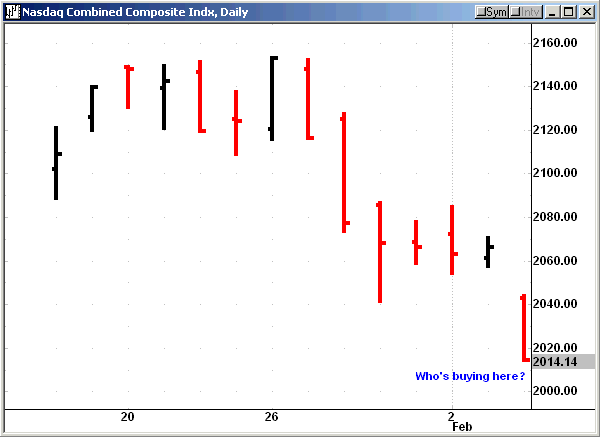Here’s When To Buy An Oversold Market
Baseball Is Back!
I love this time of the year. Both the Little League
Baseball and Girls Fast-Pitch Softball seasons are off and running here in
Southern California. Tryouts, drafts and the first practices are all behind us
and the season’s first games start in a month. This will be the first time in a
few years I’m not coaching (my wife still doesn’t believe that this is true) but
I decided to just sit back, enjoy the season, and help out whenever needed. No
Coach Mike, no phone calls at 10 pm at night from fathers who want to discuss
strategy and college scholarship potential for their 10 year olds, and certainly
no grandmothers calling defensive plays for me by screaming at their
grand-daughter to “gun her down” when a kid tries to steal second base on her.
I’m taking the easy route this Spring and do what all good parents do…second-guess every move and decision that
their kids’ manager makes during the season. And even though I suspect I’ll find
the time to be coaching again in the near future, this season I’ll be the one
dishing it out… unless of course both my kids hit first in the line-up, play
the position they were born to play, and their managers can guarantee me that
each child will receive Division I college scholarships, especially my son who
turns 6 next month.
Here Is The Best Time To Be A Buyer
This week, let’s take all the information we’ve learned
about “conventional wisdom” over the past few months from this column and put it
to use in a real-world situation. Here is the quiz:
It’s Wednesday afternoon, February 4, 2004. The market is
about to close. The Dow is down, the Nasdaq has gotten whacked 2.5% for the day
and things look bleak. The Nasdaq 100 has dropped 6 out of the past 7 days; it’s
closing under its 50-day MA for the first time in months; it’s closing near the
bottom of its range; and it has “broken down” because it’s making a new 10-day
low. The rest of the market is just as bad. The Semis are down over 10% over the past
two weeks (and are also closing at the bottom of their daily range); the VIX is
10% above its 10 period MA, signifying fear; the advancing issues on the NYSE are
having their worst day in 3 months; the TRIN is closing above 1.0 for the second
day in a row, further signifying a breakdown in breadth; and to top this all
off, the FED is hinting that they will be raising interest rates in the near
future. What do you do at the close?
a) Short the market with everyone else because it’s
“obviously heading lower.”
b) Short the market with everyone else because “things
couldn’t look worse.”
c) Short the market with everyone else because the demise
of Western civilization is near.
d) Buy the SPYs, QQQs and/or the e-mini futures on the
close.
You Of Course Already Know The Answer
If you’ve been following the research and statistical
evidence I’ve been presenting over the past few months, this quiz is easy for
you. Yes, “conventional wisdom” states that you don’t buy a market making new
lows; you don’t buy a market when it closes poorly for the day; you don’t buy a
market when the SOX is imploding; you definitely don’t buy a market the
first day it closes under its 50-day ma; you don’t buy a market when breadth is
poor; you don’t buy a market when interest rates are rising; and you
absolutely should never buy a market when all these things are
occurring the same day!

But, even though this is what the conventional wisdom
states, the statistics don’t back this up. In fact, as we have learned over the
past few months, the statistics tell us that we should not only not be a seller
during these times, but in fact, we should be a buyer! And on February 4, 2004,
when things couldn’t look worse, one was better off being a buyer than a seller. And, by being a buyer during the
time when things looked the bleakest, you were nicely rewarded over the next two
days. The Nasdaq alone rose 2.48% in 48 hours. And,
I’m writing this on Friday after the close so the potential for this move to be
even greater still exists.
Your Assignment
Take the information that has been presented here over the
past few months and re-read it. It will give you the base of understanding
needed to understand how markets work. Nearly all of the information is
statistically backed, so that gives you the peace of mind that it’s not opinion.
And even though there is no guarantee that any of this will be true in the
future, you will see themes here that occur over and over again. These themes
include looking to be a buyer when everyone else is selling when things look bad
(near 10-day lows, near the bottom of daily ranges, after multiple days down,
etc.) and looking to be a seller when everyone else is buying and when things
look great (near 10-day highs, near the top of the daily range, after multiple
up days etc.).
Choose the same spots over and over again to be a buyer.
Consistency (and some guts) are the key. Don’t get sucked up in all the hype of
how bad things are. Yes, things looked horrible this past Wednesday afternoon.
All you have to do is look above and see what was happening. Who in their
right mind would be a buyer on the close on Wednesday? Who were those
people? The people who eventually made money on Thursday and especially on
Friday.
Have a great week trading (and if you have any questions
please feel free to send them to me at
lconnors@tradingmarkets.com).
